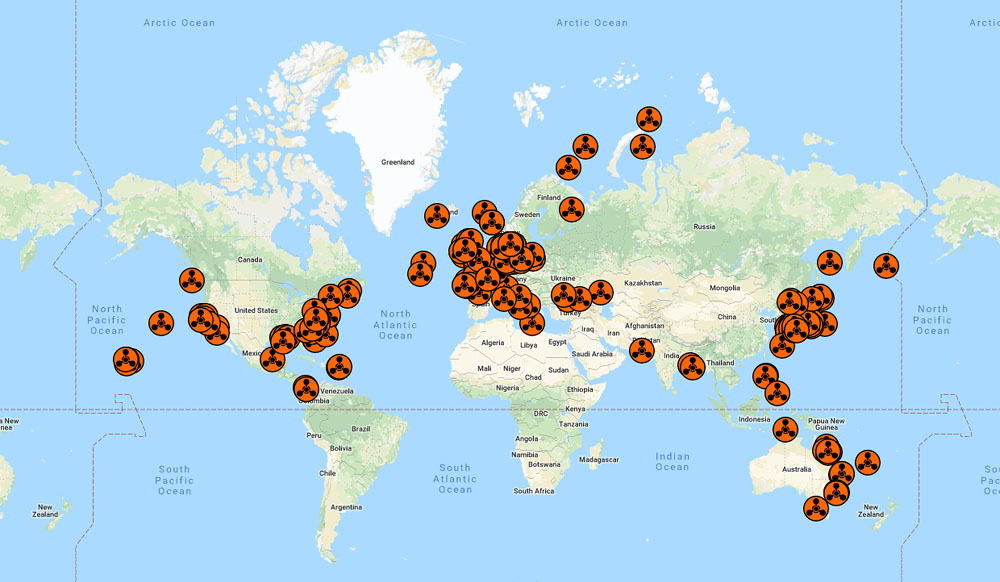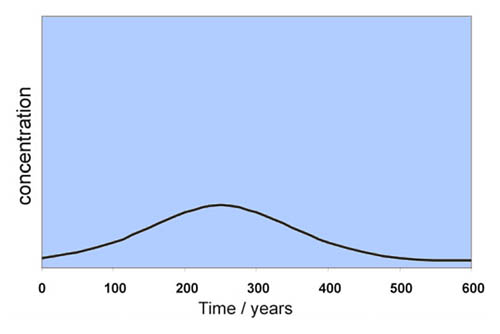Sea Dumped Conventional and Chemical Munitions
The legacy of millions of tons of sea dumped munitions will increasingly add to the already toxic oceans with
unknown consequences.
Sea Dumped Munitions
Vast quantities of conventional and chemical munitions have been extensively dumped into the oceans since World
War I, with little thought given at that time to the consequences for the environment. The underwater munitions
problem is widespread globally but has received surprisingly little attention.
While chemical weapons were not widely used during World War II, large quantities were produced and stockpiled
that became dumped at sea.

Interactive Map of Chemical Weapon Munitions Dumped at Sea
The main dumping
sites of conventional munitions include the coastal sea floor around North America, Europe, and the southwest
Pacific.
In addition to munitions dumping, 9000 military, auxiliary and merchant marine vessels were sunk during World War II. Hazards
relating to these shipwrecks include oil spills, chemical releases, unexploded ordnance. This alone poses
devastating threats to the coastal environment and the safety of human and marine life.
Typical munitions dumped at sea include: bombs. artillery shells, grenades, rockets, mines. depth charges,
torpedoes. phosphorus flares, mortars, incendiaries, cluster bombs etc. The location, quantity, and identity of
munitions were often poorly documented during disposal, and much of the information that does exist may be yet
unknown.
In German coastal waters, there are about 1.6 million
tonnes of conventional and 220,00 tonnes of chemical weapon agents. 1.3 million tonnes in the North Sea, 300,000
tonnes in the Baltic Sea. Details of the different types of munitions in the Baltic sea region can be found in this
Ammunition Risk Assessment Study, published in 2019 .
In May 2019, it was reported that mustard gas had started leaking from First World War munitions in the North Sea, close to
the Belgian coast. The munitions dump of 35,000 tons of unexploded bombs, shells and grenades, created after the
Great War, has long been considered safe. A separate report estimates the amount of
mustard gas to be 1 million litres.
In the UK coastal waters, 1.17 million tonnes of conventional and chemical weapons have been dumped, mainly in Beaufort's
Dyke, a sea trench between Northern Ireland and Scotland. All but emergency dumping ceased in 1973.
A 2018 report
notes that munitions contain organic explosive compounds as well as a variety of metals represent sources of
chemical pollution to marine waters. Most underwater munitions housings have been impacted by extensive corrosion
over the course of decades following the two World Wars. As a result, the risk of munitions related contaminant
release to the water column is increasing.
Chemicals used in conventional munitions include TNT, toluene, mercury fulminate. Mercury fulminate was the
predominant primary explosive used historically. During the two World Wars, mercury fulminate was used to such an
extent that munitions consumed as much as 15% of the global mercury production
A 2005 report funded by the UK MOD notes that a comprehensive list of dumped chemical weapons
material does not exist, as the composition of material in many dumping incidents is unknown. Typical chemical
warfare agents include: adamsite, chlorine, cyanogen chloride, hydrogen cyanide, lewisite, phosgene, sarin, soman,
sulphur mustard, tabun VX110. The report adds Prima facie the dumping of both conventional and chemical munitions in
the sea reflects a situation in which dangers to marine organisms and the potential danger to the food chain have
been ignored. However, as many commentators have indicated, alternatives to this dumping were largely unavailable,
particularly in the periods following both World War I and II when the majority of this material was dumped.
During the 1950's, approximately two tonnes of concrete-encased metal drums containing radioactive waste was
dumped into Beaufort's Dyke. A Government spokesmen insisted that the waste itself, classified as low- level and
intermediate-level, would pose no risk to health.

Concentration - versus - Time profile
for chemicals leaking from munitions.
The situation was summarised by marine biologist Stefan Nehring who was tasked with writing an assessment of pollution in the North Sea. "In the coming
decades, this is going to become a huge problem. Bombs are made of metal and metal corrodes, especially in salt
water, and eventually the various poisonous contents of the bombs will be set free and enter the ecosystem".
Already, arsenic from poison gas ammunition has been found in fish caught in the Baltic Sea.
A paper entitled Chemical munitions dump sites in coastal
environments (p. 89) indicates a time frame over which hazardous chemicals will leak from corroding munitions
casings into sea water ranging from 10 to hundreds of years.
The paper Monitoring Chemical Pollution in Europe’s Seas (p. 48) shows Russian scientists predict leakage
of chemical agents from their corroding canisters, with a peak release in the middle of the 21st Century.
A 2018 review
shows that there remain a number of knowledge gaps that limit our understanding of munitions-related contaminant
spread and effect, and the need for additional work is made all the more urgent by increasing risk of release to
the environment. The current and future release of contaminants from underwater munitions threatens to undermine
the United Nations Development Goal
14 to reduce marine pollution.















